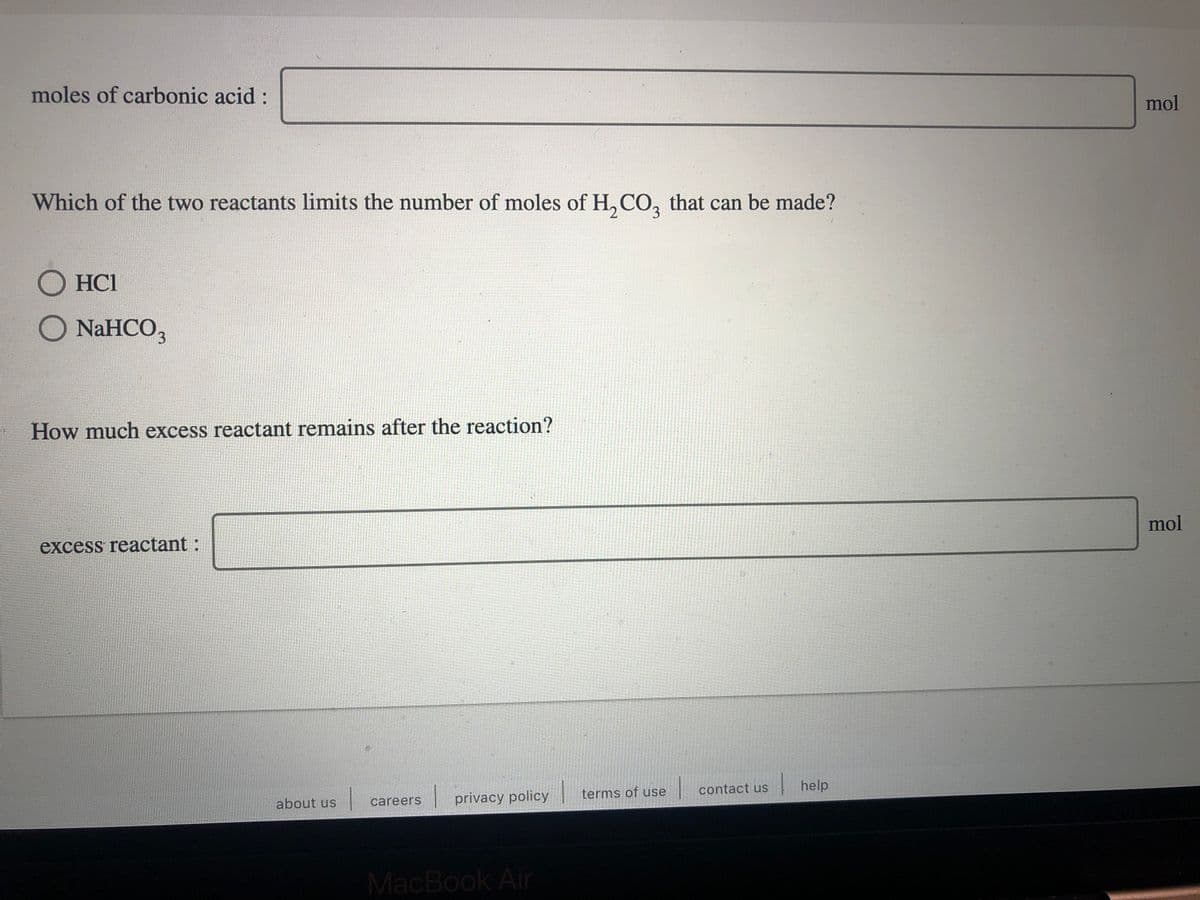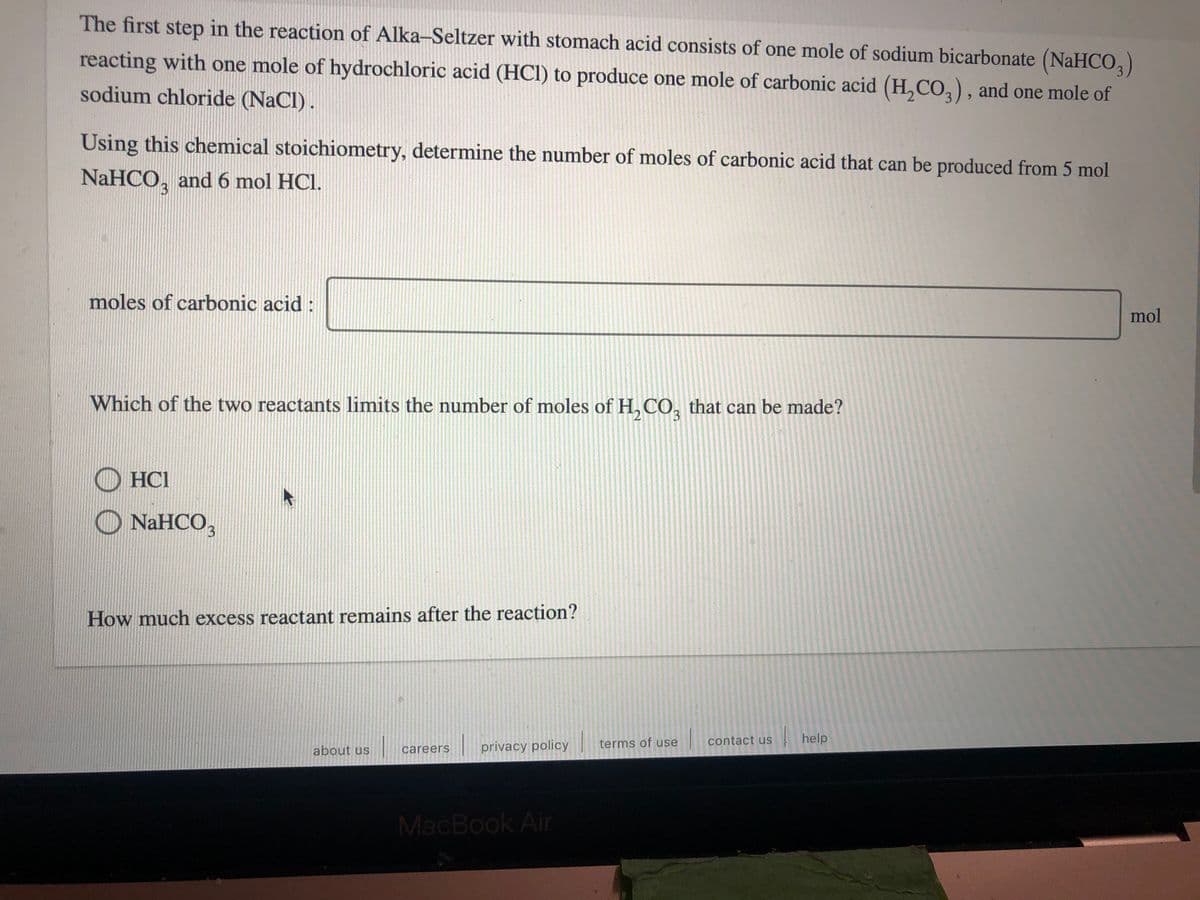UI AIka-Seltzer with stomach acid consists of one mole of sodium bicarbonate (NaHCO,) reacting with one mole of hydrochloric acid (HCI) to produce one mole of carbonic acid (H,CO,), and one mole of sodium chloride (NaCl) . Using this chemical stoichiometry, determine the number of moles of carbonic acid that can be produced from 5 mol NaHCO, and 6 mol HCI. moles of carbonic acid : mol Which of the two reactants limits the number of moles of H,CO, that can be made? HCI O NaHCO, How much excess reactant remains after the reaction?
UI AIka-Seltzer with stomach acid consists of one mole of sodium bicarbonate (NaHCO,) reacting with one mole of hydrochloric acid (HCI) to produce one mole of carbonic acid (H,CO,), and one mole of sodium chloride (NaCl) . Using this chemical stoichiometry, determine the number of moles of carbonic acid that can be produced from 5 mol NaHCO, and 6 mol HCI. moles of carbonic acid : mol Which of the two reactants limits the number of moles of H,CO, that can be made? HCI O NaHCO, How much excess reactant remains after the reaction?
Chemistry
10th Edition
ISBN:9781305957404
Author:Steven S. Zumdahl, Susan A. Zumdahl, Donald J. DeCoste
Publisher:Steven S. Zumdahl, Susan A. Zumdahl, Donald J. DeCoste
Chapter1: Chemical Foundations
Section: Chapter Questions
Problem 1RQ: Define and explain the differences between the following terms. a. law and theory b. theory and...
Related questions
Question

Transcribed Image Text:moles of carbonic acid :
mol
Which of the two reactants limits the number of moles of H, CO, that can be made?
3.
O HC1
O NAHCO,
How much excess reactant remains after the reaction?
mol
excess reactant:
contact us
| help
|privacy policy
terms of use
about us
careers
MacBook Air

Transcribed Image Text:The first step in the reaction of Alka-Seltzer with stomach acid consists of one mole of sodium bicarbonate (NaHCO,)
reacting with one mole of hydrochloric acid (HCI) to produce one mole of carbonic acid (H, CO,), and one mole of
sodium chloride (NaCl).
Using this chemical stoichiometry, determine the number of moles of carbonic acid that can be produced from 5 mol
NaHCO, and 6 mol HCl.
moles of carbonic acid :
mol
Which of the two reactants limits the number of moles of H, CO, that can be made?
O HCI
O NAHCO,
How much excess reactant remains after the reaction?
terms of use
contact us
help
about us
privacy policy
careers
MacBook Air
Expert Solution
This question has been solved!
Explore an expertly crafted, step-by-step solution for a thorough understanding of key concepts.
This is a popular solution!
Trending now
This is a popular solution!
Step by step
Solved in 2 steps with 2 images

Knowledge Booster
Learn more about
Need a deep-dive on the concept behind this application? Look no further. Learn more about this topic, chemistry and related others by exploring similar questions and additional content below.Recommended textbooks for you

Chemistry
Chemistry
ISBN:
9781305957404
Author:
Steven S. Zumdahl, Susan A. Zumdahl, Donald J. DeCoste
Publisher:
Cengage Learning

Chemistry
Chemistry
ISBN:
9781259911156
Author:
Raymond Chang Dr., Jason Overby Professor
Publisher:
McGraw-Hill Education

Principles of Instrumental Analysis
Chemistry
ISBN:
9781305577213
Author:
Douglas A. Skoog, F. James Holler, Stanley R. Crouch
Publisher:
Cengage Learning

Chemistry
Chemistry
ISBN:
9781305957404
Author:
Steven S. Zumdahl, Susan A. Zumdahl, Donald J. DeCoste
Publisher:
Cengage Learning

Chemistry
Chemistry
ISBN:
9781259911156
Author:
Raymond Chang Dr., Jason Overby Professor
Publisher:
McGraw-Hill Education

Principles of Instrumental Analysis
Chemistry
ISBN:
9781305577213
Author:
Douglas A. Skoog, F. James Holler, Stanley R. Crouch
Publisher:
Cengage Learning

Organic Chemistry
Chemistry
ISBN:
9780078021558
Author:
Janice Gorzynski Smith Dr.
Publisher:
McGraw-Hill Education

Chemistry: Principles and Reactions
Chemistry
ISBN:
9781305079373
Author:
William L. Masterton, Cecile N. Hurley
Publisher:
Cengage Learning

Elementary Principles of Chemical Processes, Bind…
Chemistry
ISBN:
9781118431221
Author:
Richard M. Felder, Ronald W. Rousseau, Lisa G. Bullard
Publisher:
WILEY